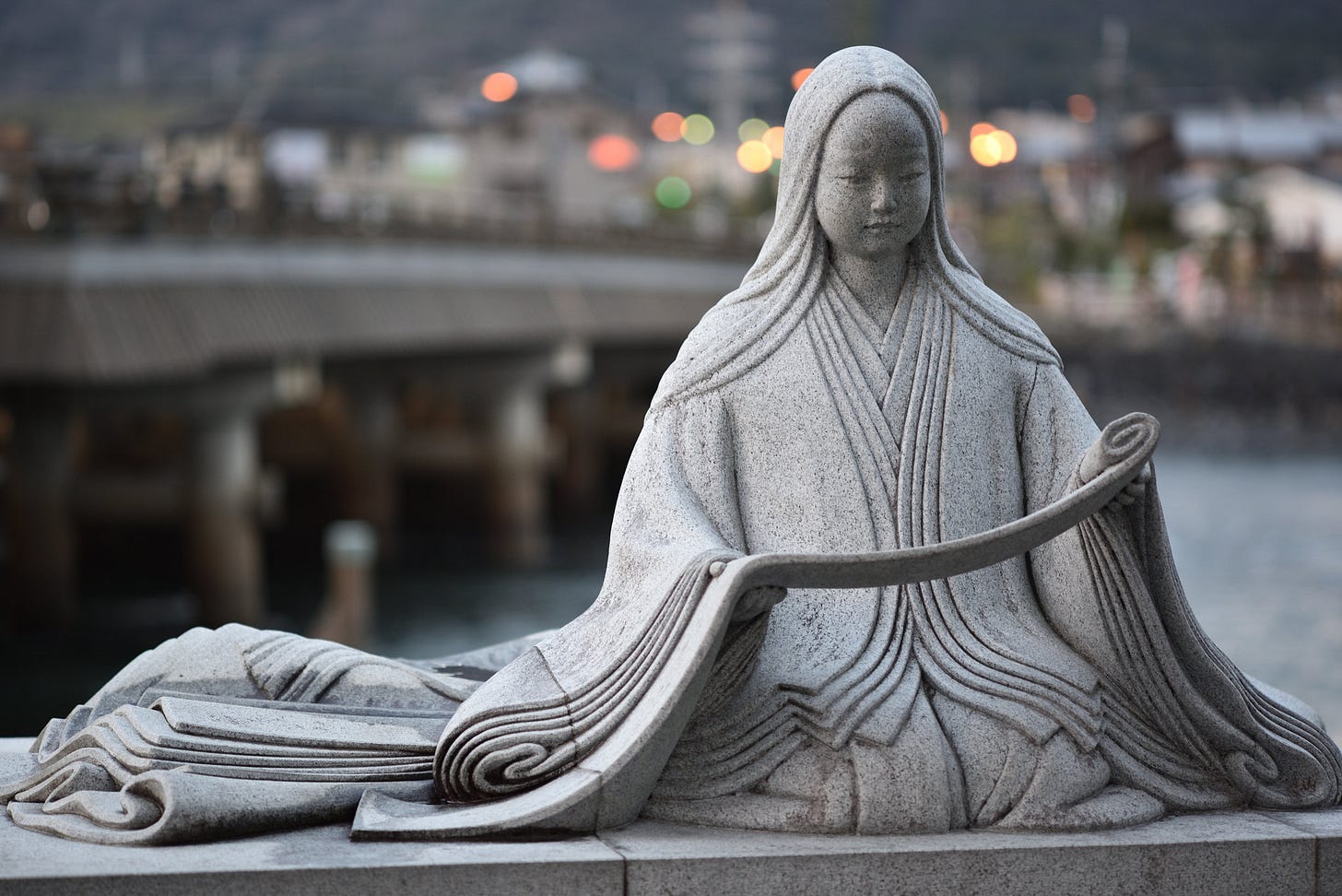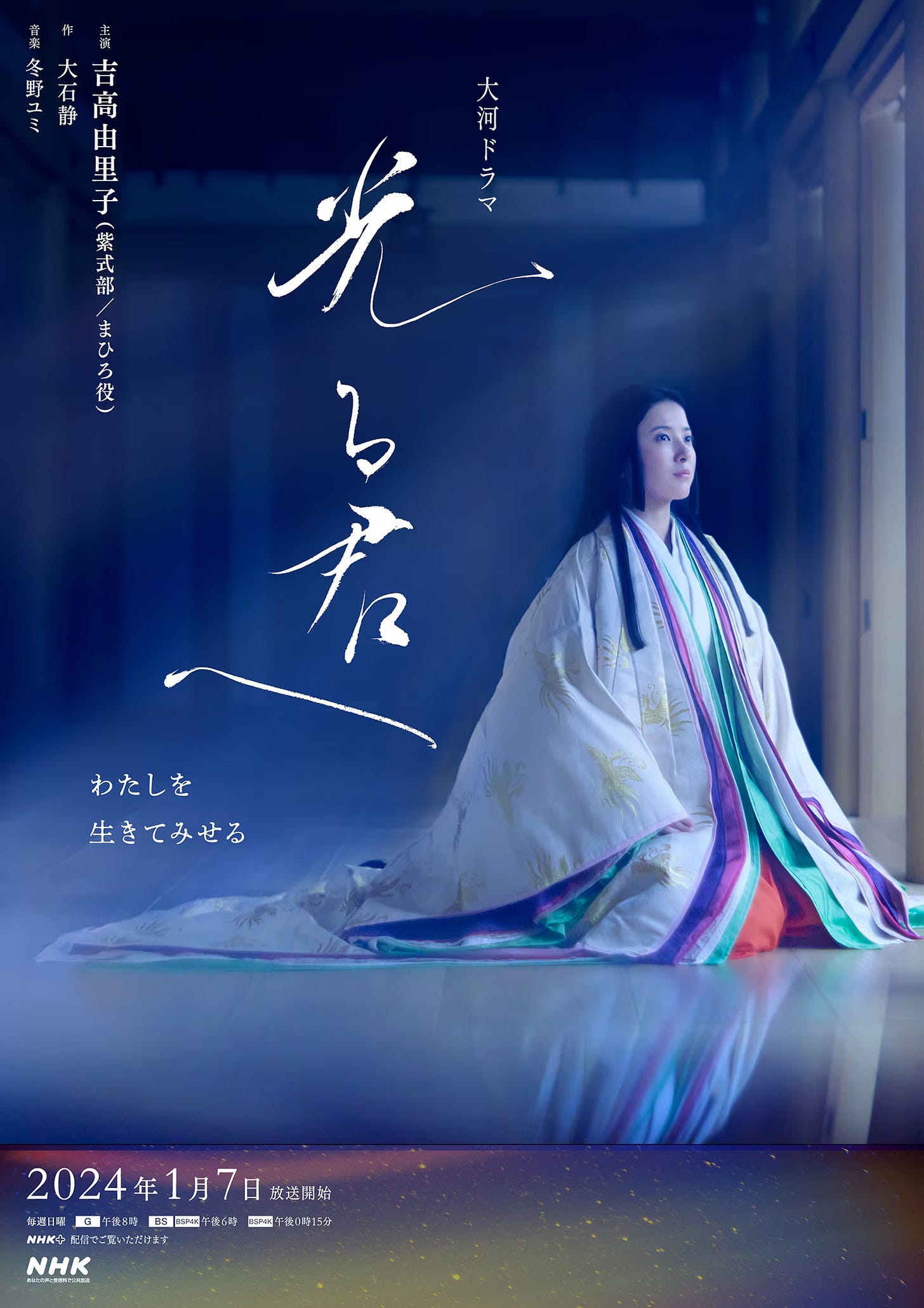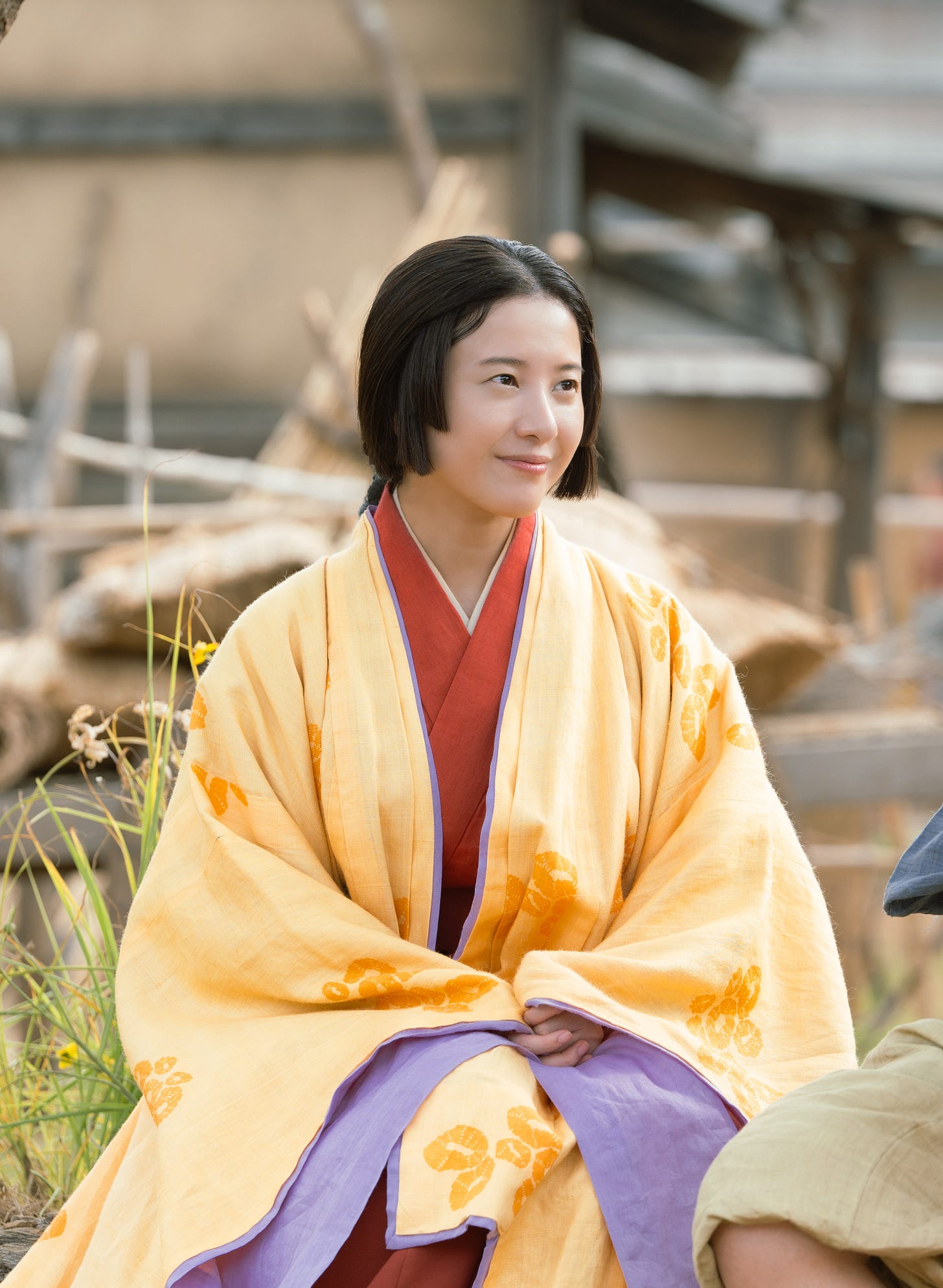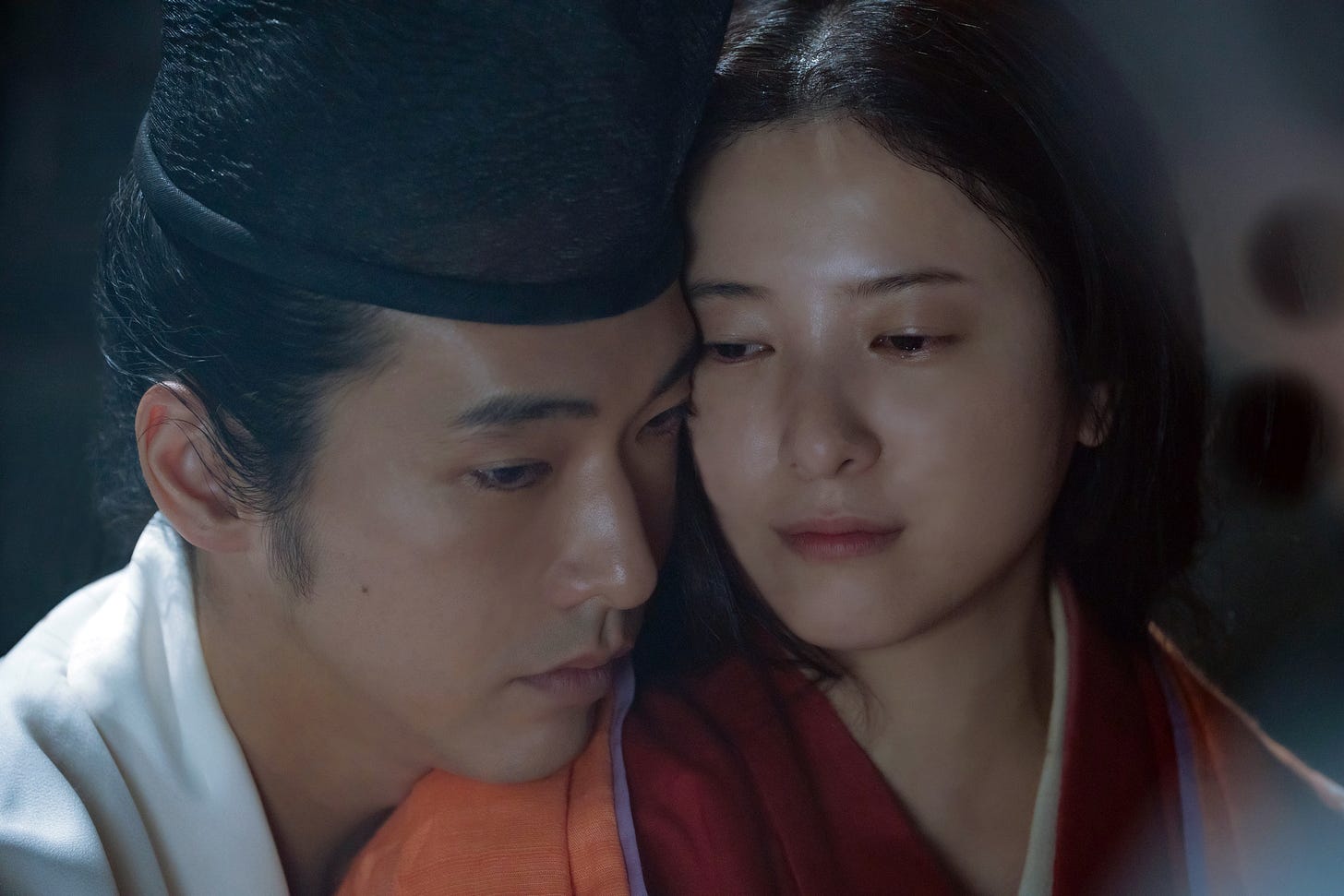
Dear readers, in my first two installments about Shiga Prefecture I mentioned that the region - and Ishiyama-dera in particular - is said to be the place where Murasaki Shikibu first got the idea for her famous novel. A few of you have expressed an interest in reading more about the subject, so I’m taking a short break from my travel report to post an article I wrote last year.
The Tale of Genji is an expansive novel, spanning over 1,000 pages in Western translations, and renowned for its intricate themes that have inspired countless interpretations over the years.
The narrative boasts a cast of around 400 characters, yet its focus remains on Genji, the illustrious Shining Prince, and the women intertwined with his romantic life, particularly Lady Murasaki. As the emperor's second son, Genji is removed from the line of imperial succession for political reasons. However, this does little to diminish his life of opulence and privilege. His nickname, “Shining,” is a testament to his extraordinary beauty, fair complexion, and impeccable fashion sense.
During his life, Genji legally marries twice: first to Aoi no Ue (Lady Aoi) at a very young age, and later to Onna san no Miya (the Third Princess). However, his most cherished lovers are Fujitsubo, the emperor’s wife, and Murasaki no Ue (Lady Murasaki), Fujitsubo's niece.
One of the most discussed aspects of The Tale of Genji is the prince's numerous romantic entanglements. While only the first dozen of the novel’s 54 chapters focus heavily on these affairs, they remain the most memorable and frequently quoted sections, solidifying Genji’s reputation as an irresistible lady-killer.
Genji’s romantic pursuits have sparked sharply divided opinions among literary critics and cultural commentators. Admirers praise him as an ideal partner for never ending his relationships with women, but a growing number of readers worldwide are challenging this view. In Japan, for instance, the term “Genji-girai” (detestation of Genji/Genji-bashing) has gained popularity among female readers, reflecting a shift in perspectives on his character and behavior.
Throughout The Tale of Genji, there are moments when Genji's actions are undeniably troubling. In Chapter 20, for example, his relentless pursuit of Princess Asagao leads to embarrassment for himself, severe distress for her, and emotional anguish for Murasaki. Critics have gone further, accusing Genji of crimes against women. Setouchi Jakucho, a novelist who translated the classic text into modern Japanese, famously remarked in a 1999 interview with The Japan Times that while Genji's romantic encounters are often described as seductions, she believed “it was all rape, not seduction.”
To understand these criticisms in context, it is essential to examine gender relations during the Heian period (794–1185). On one hand, women of this era were permitted to own, inherit, and transfer property, and figures like Murasaki Shikibu demonstrated remarkable intellectual and artistic brilliance. On the other hand, Heian society was indisputably patriarchal, with men dominating public and private spheres. Men studied Chinese and engaged in weighty matters such as moral philosophy and governance, enjoying visibility and freedom, while women typically lived secluded lives within inner chambers. Even close female relatives rarely allowed others—let alone unrelated males—a clear view of their faces.
Another key distinction from modern laws is the acceptance of polygamy among aristocrats during the Heian period. Though noblemen were theoretically limited to one wife, they often maintained two or three partners, with a defined hierarchy within these small harems. This arrangement brought inevitable challenges and, at times, tragic consequences. Commentators suggest that Heian-period women may have endured significant emotional suffering beneath the facade of outward happiness.
A prominent perspective on The Tale of Genji comes from Komashaku Kimi, a modern literature researcher who reexamined the text through a feminist lens. Her findings were presented in the essay “A Feminist Reinterpretation of The Tale of Genji: Genji and Murasaki” (U.S.-Japan Women's Journal: English Supplement, No. 5, 1993).
Komashaku highlights that both Genji's mother and Lady Murasaki's mother succumb to psychological disorders brought on by the complexities of polygamous marriages. Genji himself perpetuates this pattern: he marries Lady Aoi at just twelve, later abducts Lady Murasaki as a child and keeps her as an unofficial wife, and eventually weds the Third Princess, whose marriage causes Lady Murasaki such anguish that she dies.
Broadly, Komashaku argues that Murasaki Shikibu, the novel's author, portrayed women's suffering as a direct result of men's reckless philandering. She suggests that the true protagonists of The Tale of Genji are not Genji himself, but the women whose lives are shaped—and often devastated—by his actions.
On the other side of the debate are those who argue that The Tale of Genji must be understood as a product of its time. Among them is Royall Tyler, a British scholar and writer whose 2003 translation of Shikibu’s novel received widespread acclaim.
In his essay “Marriage, Rank and Rape in the Tale of Genji” (Intersections: Gender, History and Culture in the Asian Context, Issue 7, March 2002), Tyler examines the role of social rank in shaping gender and sexual relations. He contends that in the Heian period, “forced sexual intercourse has a significance unimaginable in the contemporary world.” Tyler also describes the gender dynamics in the novel as “humane in tone,” asserting that “there is no trace of physical violence against women.” Critics might counter, however, that the absence of explicit sex scenes does not imply the absence of sexual activity, which is pervasive throughout the story.
The most contentious aspect of gender relations in The Tale of Genji is the depiction of rape. Tyler acknowledges that rape occurs in the tale but argues that “an attentive reading of the tale shows that no young woman of good family could decently, on her own initiative, say yes to first intercourse.” He explains that “a lady in the tale did not do that, in which she resembled many other respectable ladies in other countries and times.” In other words, Tyler suggests that while a woman might desire a sexual relationship, societal norms prevented her from openly expressing consent. This interpretation applies to Oborozukiyo, one of the women Genji forces himself upon. According to Tyler, her “failure to resist Genji seriously reminds him that, despite her charm, she has unfortunately not been brought up to what he considers the highest standard.”
To emphasize the supposed good intentions of Heian-period men, Tyler argues that “a man courting a woman socially worthy of him (…) does not in principle take initial intercourse with her lightly. In the tale, such intercourse is typically the beginning of a long-term relationship.” In practical terms, while rape is inherently wrong, Tyler suggests that a woman might ultimately benefit from such an incident.
Consider the case of Suetsumuhana, a lady in dire straits after losing her father. According to Tyler, when Genji adds her to his list of conquests, “her house [is] slowly collapsing around her.” As a “real lady,” she resists Genji’s advances, leaving him, as Tyler puts it, “no choice but to proceed without her consent.” However, Tyler argues that Genji’s “decisiveness saves her life not once but twice.” Following their encounter, Genji commits to her, renovates her house and grounds, and provides for her and her household. Tyler concludes, “She literally owes him everything.”
While there are numerous instances of forced intimacy in the novel, the central episode revolves around Genji’s relationship with Lady Murasaki. Murasaki is about ten years old when Genji, then 17, first encounters her and immediately desires her. Her grandmother believes she is too young and advises Genji to wait a few years before proposing. Murasaki’s mother has passed away, and her father, a prince, remains alive but distant.
Because her mother was not the prince’s legal wife, his official wife harbored deep animosity toward both Murasaki’s mother and the child, a reflection of the toxic environment fostered by polygamy. As a result, Murasaki’s father has never acknowledged her or brought her into his home, fearing the treatment she would face.
Although Murasaki’s grandmother explicitly declared her off-limits for the time being, Genji manages to gain access to the place where she is staying. His intrusion into the child’s bedroom terrifies her, leaving her trembling with fear—a reaction Genji disturbingly finds both appealing and charming. Eventually, he abducts her.
Komashaku Kimi highlights this behavior, noting that “although Genji is commonly regarded as a kind and good-hearted hero, we can see in the cases of Yugao [another of his ‘conquests’] and Murasaki that he abducts women by force.” Even Royall Tyler concedes that Genji’s actions are outrageous. However, Tyler defends him by arguing, “does it harm Murasaki? Considering the realities of her life and her prospects, the answer is no, on the contrary. At her father's house, she would be (…) no more than an unwanted stepchild, a sort of Cinderella.”
At Genji’s palace, Murasaki is treated with what Tyler describes as “unfailing tact and respect.” Despite sleeping beside her each night, he refrains from touching her while she matures. When Murasaki turns 14, Genji’s first wife dies, prompting him to view the girl in a new light. Initially, he attempts to subtly express his desires, but Murasaki either fails to grasp his intentions due to her naivety or sees him as a father figure and finds the prospect of intimacy with him repulsive. Regardless of her reasons, Murasaki does not respond to his advances, leading Genji to take her by force.
Here is where interpretations of Murasaki’s behavior diverge. Tyler reiterates his belief that a “real lady” neither openly consents to a sexual advance (as it would compromise her dignity) nor outright refuses (as it would embarrass Genji). Instead, she feigns ignorance, a response that Genji interprets as tacit approval.
Komashaku Kimi offers a similar yet far bleaker perspective. She argues that “even if [a woman] could fight back, any forceful action by her was condemned as blemishing her femininity. Thus, women's reactions were restricted to the posture of ‘endurance’ or ‘grief’.”
Tyler defends Genji’s actions by asserting, “There is no reason to believe that Genji is wrong by the standards of his time. He seems even to have been unusually patient. (…) The experience is inevitable, but once it is over, it is over.” While Tyler acknowledges that “Murasaki remains furious with him for some time thereafter,” he insists that her anger eventually subsides. Furthermore, he downplays the significance of her loss of virginity, suggesting that “life will bring her great happiness; and in the end, it will lift her, for the reader, to a height of grandeur beyond anything her yes or no could have achieved.”
Komashaku’s critique is particularly harsh: she argues that “Murasaki's resistance arouses no guilt in Genji, who believes that he is doing her a favor by supporting and marrying her. From a woman's point of view, however, what happened is clearly rape.” She further observes that Murasaki “remains hostile toward Genji (…) She has stopped looking Genji in the eye, refusing to warm to him even when he approaches her in a playful manner. In a sudden transformation from her previous self, Murasaki seems withdrawn and stricken by grief.”
Fast forward 18 years, during which the Shining Prince continues his philandering. At the age of 40, Genji marries the Third Princess of the retired emperor Suzaku, making her his principal wife. Murasaki, though arguably the love of his life, remains legally a quasi-wife due to complex circumstances preventing formal marriage.
This new union devastates Murasaki. Unable to bear sharing the palace with the new wife, she expresses her wish to become a nun. Genji, however, cannot fathom that a woman who has lived in luxury under his care could feel such misery. He denies her request, keeping her by his side until, slowly consumed by grief, she passes away at the age of 43.
After Murasaki’s death, Genji contemplates retiring to a temple. Komashaku Kimi criticizes his subsequent abrupt disappearance from the story as “too anticlimactic for him to be the true protagonist.” She argues that “Murasaki Shikibu was no longer interested in writing about Genji. (…) I cannot think of Genji as the center of the text. I consider him to have been an instrument for developing stories with the consistent theme of female suffering. (…) If this is the case, it is only appropriate that Genji disappear from the text shortly after Murasaki's death.”
Komashaku and other modern female commentators have pointed out that The Tale of Genji is often celebrated as romantic because much of the scholarship on the text has been conducted by male critics enamored with Genji’s charismatic yet patriarchal behavior toward women.
Among these is Ian Buruma, who in his 2015 essay “The Sensualist,” published in The New Yorker, interprets The Tale of Genji as a story centered on the art of seduction. Buruma suggests that “Genji loves all his women in his own way” and describes his devastation over Murasaki’s early death as one of the book’s most moving scenes.
Komashaku finds the scene moving as well, but for entirely different reasons. Reflecting on Genji’s life trajectory, she concludes that he could not have been the true protagonist of the story. “If Genji were truly meant to be the leading hero,” she writes, “Murasaki Shikibu probably would not have made him such an impertinent and unsavory character, a self-absorbed, callous, and inconsiderate womanizer. I think Genji's insensitivity indicates that he had a supporting role, that he functioned as a foil for the elaboration of the stories of the heroines.”
The morning after her abduction, Murasaki steps onto the verandah of Genji’s lavish palace and gazes out at the garden. Her attention is soon drawn to “the beautiful screen paintings that decorate the rooms.” Yet, as the section concludes, the author poignantly remarks, “It is pitiful that a child comforts herself by looking at the paintings.” According to Komashaku, “rather than celebrating Murasaki's good fortune, the narrator grieves over the girl's fate.”
Murasaki Shikibu believed that the lives of the women in The Tale of Genji were fraught with misery. This sentiment is not confined to her fiction - Komashaku notes that the author’s diary is similarly steeped in darkness, reflecting the unresolved pain of being a woman in her time.
Whether one views these women’s lives as fortunate or tragic depends largely on personal perspectives on marriage and gender relations. Heian-period readers, for example, might not share Komashaku’s judgment of Genji as “self-absorbed, callous, and inconsiderate.” After all, Genji was incredibly handsome, well-born, talented, and sufficiently gentle and kind by the standards of his era.
Nevertheless, even without the lens of the #MeToo movement, certain behaviors in the text are undeniably condemnable.
Have you read The Tale of Genji? What do you think about the book and the controversy surrounding the story?







Shining prince is the only acceptable answer.
I haven't read this book and I don't intend to. Yes, you have to see it through a cultural/historical lens but it doesn't make the subject matter palatable. I don't think he is either. All players were part of their times and culture, and their 'lot in life' went unquestioned. I can't read a book like this without my feminist hat planted firmly on my head, but that shows that I am a product of my times and culture!